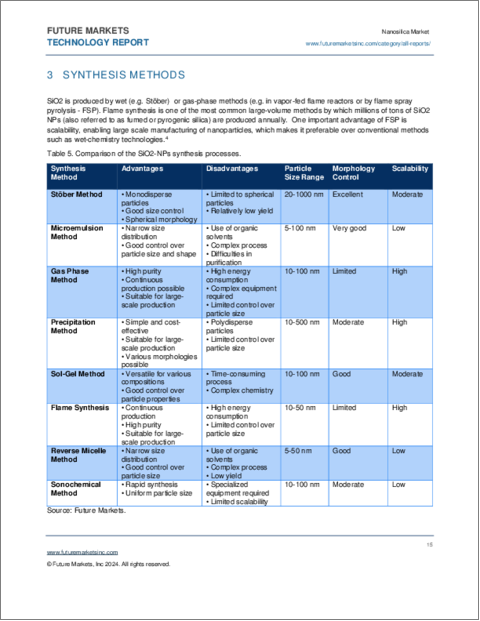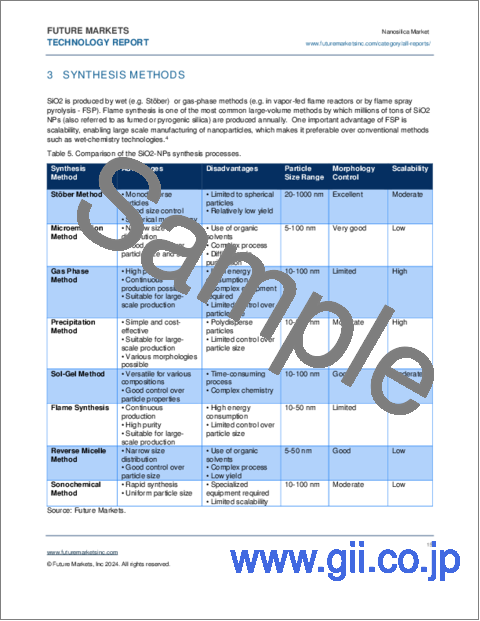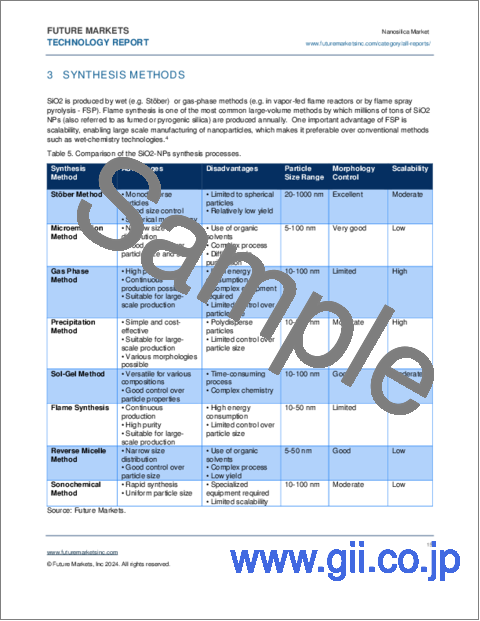|
|
市場調査レポート
商品コード
1563428
シリカナノ粒子の世界市場(2025年~2035年)The Global Market for Silicon Dioxide Nanoparticles 2025-2035 |
||||||
|
|||||||
| シリカナノ粒子の世界市場(2025年~2035年) |
|
出版日: 2024年09月23日
発行: Future Markets, Inc.
ページ情報: 英文 67 Pages, 32 Tables, 5 Figures
納期: 即納可能
|
全表示
- 概要
- 図表
- 目次
ナノシリカとしても知られるシリカナノ粒子は、バルクシリカとは異なるユニークな特性を持っています。ナノシリカ粒子の高い表面積対体積比は、反応性の向上と分子レベルでの他の材料との相互作用能力の向上に寄与しています。ナノシリカは、電子、医療、建設、材料科学などの多様な分野で使用され、その用途において顕著な多用途性を示しています。電子産業では、半導体製造や先進センサーのコンポーネントとして重要な役割を果たしています。医療部門では、ドラッグデリバリーシステム、バイオメディカルイメージング、歯科材料の補強剤としてナノシリカが利用されています。建設では、これらのナノ粒子はコンクリートなどの建材の強度と耐久性を大幅に向上させます。シリカナノ粒子の合成は、ゾルゲル法、火炎熱分解、マイクロエマルション技術などのさまざまな方法で行うことができます。
当レポートでは、世界のシリカナノ粒子市場について調査分析し、市場規模と成長予測、特性と合成方法、利用情勢、競合情勢、規制と安全性などの情報を提供しています。
目次
第1章 エグゼクティブサマリー
- ナノ材料の特性
- 分類
- 世界のナノ粒子/粉末市場
- シリカ(SiO2)ナノ粒子/粉末市場
第2章 特性
第3章 合成法
- ストーバー法
- マイクロエマルション法
- 気相法
- 沈殿法
- その他の合成方法
第4章 市場セグメントの分析
- 接着剤
- 使用の動機
- 用途
- バイオ医療
- 使用の動機
- 用途
- 触媒
- 使用の動機
- 用途
- セメント
- 使用の動機
- 用途
- コーティング
- 使用の動機
- 用途
- 複合材料
- 使用の動機
- 用途
- 電子
- 使用の動機
- 用途
- 潤滑剤
- 使用の動機
- 用途
- ゴム
- 使用の動機
- 用途
- その他
- 食品添加物
- 化粧品
- プリンタートナー
- バッテリー、スーパーキャパシター
第5章 市場のバリューチェーン
第6章 規制と安全性
- 規則
- 欧州
- 北米
- アジア太平洋
- 毒性と安全性
第7章 技術準備レベル(TRL)チャート
第8章 価格と価格決定要因
第9章 世界のシリカナノ粒子/粉末の市場需要
- 需要(トン数)(2020年~2035年)
- 世界の総需要
- 需要:市場別(2020年~2035年)
- 需要:地域別
第10章 メーカーとサプライヤーのプロファイル(企業28社のプロファイル)
第11章 付録
第12章 参考文献
List of Tables
- Table 1. Categorization of nanomaterials
- Table 2. The Global market for nanomaterials in 2024 in tons, market characteristics and growth prospects
- Table 3. Market overview for Silicon dioxide (SiO2) nanoparticles/powders -Selling grade particle diameter, usage, advantages, average price/ton, high volume applications, low volume applications and novel applications
- Table 4. Silicon Dioxide Nanoparticles (SiO2-NPs) Properties and Applications
- Table 5. Comparison of the SiO2-NPs synthesis processes
- Table 6. Other Synthesis Methods for Silicon Dioxide (SiO2) Nanoparticles/Powders
- Table 7. Markets, benefits and applications of silicon oxide nanoparticles/powders
- Table 8. Motivation for Use in Adhesives
- Table 9. Applications in Adhesives
- Table 10. Motivation for Use in Biomedicine
- Table 11. Applications of silicon dioxide NPs in biomedicine
- Table 12. Comparison of the SiO2- NPs-based drug delivery systems
- Table 13. Motivation for Use in Catalysts
- Table 14. Applications of silicon dioxide NPs in catalyst
- Table 15. Motivation for Use in Cement
- Table 16. Applications of silicon dioxide NPs in cement-based materials
- Table 17. Motivation for Use in Coatings
- Table 18. Applications of silicon dioxide NPs in coatings
- Table 19. Motivation for Use in Composites
- Table 20. Applications of silicon dioxide NPs in composites
- Table 21. Motivation for Use in Electronics
- Table 22. Applications of silicon dioxide NPs in Electronics
- Table 23. Motivation for Use in Lubricants
- Table 24. Applications of silicon dioxide NPs in Lubricants
- Table 25. Motivation for Use in Rubber
- Table 26. Applications of silicon dioxide NPs in Rubber
- Table 27. Market value chain for Silicon dioxide nanoparticles/powders
- Table 28. Regulations for Silicon Dioxide Nanoparticles/Powders
- Table 29. Global demand for Silicon dioxide nanoparticles/powders, conservative and optimistic estimates (tons), 2020-2035
- Table 30. Global demand for Silicon dioxide nanoparticles/powders, by market 2020-2035 (tons)
- Table 31. Global demand for Silicon dioxide nanoparticles/powders, by region 2020-2035 (tons)
- Table 32. Technology Readiness Level (TRL) Examples
List of Figures
- Figure 1. Schematic diagram representing the history and development of silica particles and silica nanoparticles (SNP) with different surface morphology and modifications
- Figure 2. Technology Readiness Level for Silicon Dioxide Nanoparticles/Powders
- Figure 3. Global demand for Silicon dioxide nanoparticles/powders, conservative and optimistic estimates (tons), 2020-2035
- Figure 4. Global demand for Silicon dioxide nanoparticles/powders, by market 2020-2035 (tons)
- Figure 5. Global demand for Silicon dioxide nanoparticles/powders, by region 2020-2035 (tons)
Silicon dioxide nanoparticles, also known as nanosilica, offer unique properties that differ from bulk silica. The high surface area to volume ratio of nanosilica particles contributes to their enhanced reactivity and ability to interact with other materials at a molecular level. Nanosilica exhibits remarkable versatility in its applications, finding use in diverse fields such as electronics, healthcare, construction, and materials science. In the electronics industry, it plays a crucial role in semiconductor manufacturing and as a component in advanced sensors. The healthcare sector utilizes nanosilica in drug delivery systems, biomedical imaging, and as a reinforcing agent in dental materials. In construction, these nanoparticles significantly improve the strength and durability of concrete and other building materials. The synthesis of silicon dioxide nanoparticles can be achieved through various methods, including sol-gel processes, flame pyrolysis, and microemulsion techniques. This comprehensive market report provides an in-depth analysis of the global nanosilica market, offering valuable insights for manufacturers, investors, and stakeholders in the nanotechnology sector.
Report contents include:
- Market Size and Growth Projections: Detailed forecasts of the nanosilica market size and growth rate from 2020 to 2035, segmented by application and region.
- Properties and Synthesis Methods: Comprehensive overview of nanosilica properties and various synthesis techniques, including the Stober method, microemulsion method, gas phase method, and precipitation method.
- Application Landscape: In-depth analysis of key application areas such as adhesives, biomedicine, catalysts, cement, coatings, composites, electronics, lubricants, and rubber industries.
- Competitive Landscape: Profiles of 28 leading companies and emerging players in the nanosilica space, including their technologies, strategies, and market positioning. Companies profiled include BYK Chemie GmbH, Evonik, Fuji Chemical, Green Resource Co., Ltd., Ionic Mineral Technologies, Kinaltek and Promethean Particles.
- Regulatory and Safety Analysis: Examination of global regulations, toxicity concerns, and safety measures related to nanosilica production and use.
- Emerging Technologies and Innovation:
- Advanced drug delivery systems and cancer therapies
- Novel bioimaging techniques and biosensors
- High-performance catalysts for various chemical processes
- Innovative coatings with enhanced scratch resistance, anti-reflection, and flame-retardant properties
- Market Drivers and Opportunities
- Challenges and Market Dynamics
- Regional Analysis and Market Opportunities
- Technology Readiness Level (TRL) Analysis
- Price Analysis and Market Value Chain
TABLE OF CONTENTS
1. EXECUTIVE SUMMARY
- 1.1. Properties of nanomaterials
- 1.2. Categorization
- 1.3. The global market for nanoparticles/powders
- 1.4. Silicon dioxide (SiO2) nanoparticles/powders market
2. PROPERTIES
3. SYNTHESIS METHODS
- 3.1. Stober method
- 3.2. Microemulsion method
- 3.3. Gas phase method
- 3.4. Precipitation method
- 3.5. Other Synthesis Methods
4. MARKET SEGMENT ANALYSIS
- 4.1. Adhesives
- 4.1.1. Motivation for use
- 4.1.2. Applications
- 4.2. Biomedicine
- 4.2.1. Motivation for use
- 4.2.2. Applications
- 4.2.2.1. Drug delivery and cancer therapy
- 4.2.2.2. Bioimaging
- 4.2.2.3. Biosensors
- 4.2.2.4. Implants
- 4.3. Catalysts
- 4.3.1. Motivation for use
- 4.3.2. Applications
- 4.4. Cement
- 4.4.1. Motivation for use
- 4.4.2. Applications
- 4.5. Coatings
- 4.5.1. Motivation for use
- 4.5.2. Applications
- 4.5.2.1. Scratch Resistant Coatings
- 4.5.2.2. Anti-reflection Coatings
- 4.5.2.3. Anti-corrosion Coatings
- 4.5.2.4. Flame Retardant Coatings
- 4.6. Composites
- 4.6.1. Motivation for use
- 4.6.2. Applications
- 4.7. Electronics
- 4.7.1. Motivation for use
- 4.7.2. Applications
- 4.8. Lubricants
- 4.8.1. Motivation for use
- 4.8.2. Applications
- 4.9. Rubber
- 4.9.1. Motivation for use
- 4.9.2. Applications
- 4.10. Other
- 4.10.1. Food additives
- 4.10.2. Cosmetics
- 4.10.3. Printer toners
- 4.10.4. Batteries and supercapacitors
5. MARKET VALUE CHAIN
6. REGULATIONS AND SAFETY
- 6.1. Regulations
- 6.1.1. Europe
- 6.1.2. North America
- 6.1.3. Asia-Pacific
- 6.2. Toxicity and safety
7. TECHNOLOGY READINESS LEVEL (TRL) CHART
8. PRICE AND PRICE DRIVERS
9. GLOBAL MARKET DEMAND FOR SILICON DIOXIDE NANOPARTICLES/POWDERS
- 9.1. Demand in tons, 2020-2035
- 9.1.1. Total global demand
- 9.1.2. Demand by market 2020-2035
- 9.1.3. Demand by region
10. PRODUCER AND SUPPLIER PROFILES 48 (28 company profiles)
11. APPENDICES
- 11.1. Research methodology
- 11.2. Aims and objectives of the study
- 11.3. Technology Readiness Level (TRL)





